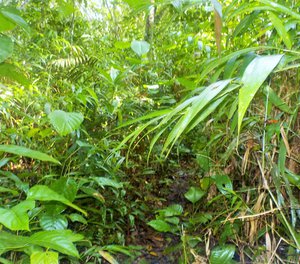Advertisement

 The jungle path. Where?
The jungle path. Where?
Good thing we have a guide with a machete!Tuesday 26
th may 2015
Canoeing through the jungle is one thing, but trekking through dense jungle is quite another. Today we set off for a three hour trek and it was pretty challenging. We had a big storm in the night with torrential rain, so the forest was steaming and the insects were ferocious. We crossed streams, got through dense undergrowth (Marcelo was busy up front with his machete), climbed over numerous fallen trees and we saw Jaguar tracks. Some Tamarind Monkeys were high up in the canopy and moths the size of a man´s hand flew through the foliage. Although close to being unbearable at times, undoubtedly on the very edge of our comfort zone, it was also enormously exciting and we learned a lot about survival techniques and about the flora around us. We also collected Brazil nuts, which taste so good when fresh, more rich and oily than those bought in the supermarket at home. Brazil nut trees are huge and the pods contain an average of sixteen nuts. Marcelo cut one open with his machete, so that we could eat the nuts and it was not easy, they have very thick hard shells. Several

 Getting bark from the Killer Tree
Getting bark from the Killer Tree
Viv says it is for a necklace not a garrotte. John is a bit worried!shells lying on the forest floor had been gnawed open by big Amazonian rats, which are the size of large domestic cats and weigh around four kilograms; glad we never met any of those this morning! Their jaws must be very powerful! We are bringing one of the pods home as a souvenir!
There is a tree called the “Killer Tree” the “Mata Mata” so called because the sinew under the bark can be split, dried and made into very strong rope and the Indians traditionally used it to make garrottes. Nowadays, the Indian women plait it to make necklaces and bracelets. We have some of the sinew to bring home with us also. Viv plans to make it into a necklace. Another interesting tree is locally called the “Red Ball Tree” because its red iron-rich roots, which grow above the ground, are made into tea to feed to the children. Many indigenous Indian children suffer with anaemia here. Its correct name is the “Agai”. Another spikey palm stem, which is hollow, is used to make blowpipes, once the lethal spikes have been removed.
The Termite nests are alive with tiny crawling mites, but

 A bridge over troubled waters?
A bridge over troubled waters?
All sorts of nasty things down there!apparently they make a good mosquito repellent. Marcelo placed his hand on the nest, allowing these things to crawl all over his hand, then he quickly withdrew his hand, killed them and rubbed them into his skin. We got out our DEET spray instead!
This afternoon, we went with Marcelo and Jogo, who is the manager of the lodge, across the wide river to visit some Indian friends of theirs, who live on the northern bank. Jogo is over-the-top effeminate, great lovely guy; he wears false nails. Jogo took a big garden sun umbrella with him to use as a parasol against the fierce afternoon sun! As one does! The patriarch of the family across the river is called Louis and he has twenty-eight children and three wives! One of his grandchildren is the cook at the lodge, i.e. the one who guts and barbecues the river fish to serve with the plain boiled rice, which we get at every meal. Actually for lunch today we had “chicken” and rice. It was not chicken, however. The bones were too small and one piece obviously was a head, about the size of a small bird, because it had
an eye in it! Tonight was fish stew and rice! Louis and his family grow Manioc potatoes, which they ferment then cook to make flour and it was really interesting to watch them doing this. They make a decent living out of the Manioc, because the flour, the “Farinha de Mandioca” is served everywhere in Brazil, as a condiment, to sprinkle all over one´s meal. It is totally tasteless! It is also made in to bread.
This huge extended family, who all live together in raised up houses, which makes up a whole little one-family village, live a very basic existence. They share their environment with pigs, chickens, dogs, cats, a pet three and a half metre long Boa Constrictor and mess and rubbish. They were very welcoming, however and obviously Marcelo is very fond of them. They have some unusual ornaments in the house, like the skull of a four and a half metre black Caiman that Louis killed some years ago, and the skin of a nine metre Anaconda, similarly despatched to reptile heaven. There is a large Caiman living near their house at the moment, who ate two of their pigs recently. It was

 Harvesting Brazil nuts
Harvesting Brazil nuts
The best food we ate all week!an interesting afternoon! John got his face painted with Urucum, from the fruit of a tree growing outside their house. The red Urucum dye is used for food colouring as well as face painting.
After a very full day, we made our way back across the river, saw a big pink dolphin as a bonus on the way, to eat our fish stew and relax for the evening. Yet another great day here in the jungle! This is a great place and it is giving us a rich and rewarding experience. Shame about the food!
Advertisement
Tot: 0.164s; Tpl: 0.028s; cc: 5; qc: 28; dbt: 0.1134s; 1; m:domysql w:travelblog (10.17.0.13); sld: 1;
; mem: 1.1mb




















